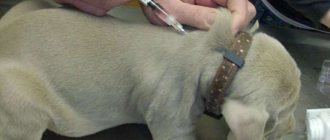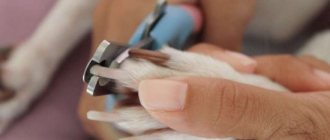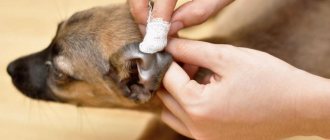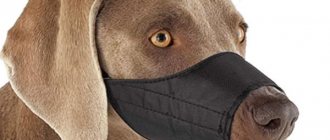Dogs, like people, get sick too. The owner begins to worry, and for good reason: sometimes a mild disease develops into a complicated one, where serious intervention cannot be avoided. In this case, contacting the veterinarian ends with giving an injection. Further treatment is usually lengthy, and then you need to decide whether to go to the doctor every day or find out how to give the dog an injection at home yourself. We invite you to find out everything about this to help your faithful friend recover!
How to prepare your dog for an injection
Giving an injection to a dog if it is nervous is possible, but difficult. If this is a pet of a large breed or is under stress, then it is impossible. Calmness is necessary for both the pet and its owners if they want the first injection and subsequent ones not to be accepted as an act of aggression on the part of a person.
global $ads_google; //data-ad-slot=”2475549904″ $ads_google = empty($ads_google) ? false : true; ?> if ($ads_google == false) {?>
$ads_google = true; ?> } ?>
Excessive zeal and the desire to inject an animal at any cost can result in the needle breaking or getting stuck in the patient’s body. The harm from such actions is obvious, and the needle itself cannot be pulled out.
If the owner has concerns, it makes sense to put a muzzle on the family pet, even if it is a small breed dog, at least for the first time.
The pet’s fear is understandable, so the one who the dog trusts unconditionally should stab. You should sit next to your friend, talk affectionately and lay him on his side. The pet's paws need to be confidently held. At this moment, the relaxed dog is given an injection. Immediately after the procedure, give your favorite treat. The next such manipulation will no longer scare the furry friend and will pass calmly.
Necessary preparations
When the syringe is selected, it is necessary to open the ampoule with the drug. It doesn’t matter what kind of drug it is - oxytocin to stimulate labor or specific antibiotics for dogs in injections - the ampoule must be opened. Manufacturers either include a special nail file with the medicine packaging, or simply mark a special place on the ampoule, pressing on which will simply break it.
The ampoule is opened, and then, the main thing is not to miss an important point - with cotton wool soaked in alcohol, you need to wipe the upper (broken) part of the ampoule - to remove all possible bacteria that could get on it from your hands. Of course, many people wash their hands before opening the medicine, but even washed hands are no guarantee.
There are several rules for handling medications, and they are valid not only for injections for dogs, but also for any injections:
- It is necessary that the hands performing the procedure are clean.
- Each new injection of the drug must be made with a sterile needle.
- Under no circumstances should the needle be touched with your hands.
- Ampoules, even containing another half of the drug, are prohibited from being stored.
If the first points do not raise any special questions, then the last one may cause confusion. How can you throw away an ampoule with half a drug, the cost of which can be equal to the cost of a dog? Fortunately, the remaining drug can be drawn into a new syringe for the next injection - if stored correctly (i.e., following the other rules and storing the syringe in the refrigerator with a cap on the needle), this will not cause difficulties, but such a syringe can be stored for no more than three days.
Sometimes an animal requires a dose of medicine that exceeds the volume of one ampoule - then the medicine from several ampoules is simply drawn into a syringe of the appropriate size.
When the medicine is drawn up, you should turn the syringe over with the needle up and, slowly pressing the plunger, lightly hit the plastic with your finger several times. In this way, air is removed from the syringe, because its presence in the medicine can be harmful to the animal.
Where are injections given to dogs?
The site of administration of the drug depends on the drug itself and its purpose. At home, only two types of injections are given:
- Intramuscular;
- Subcutaneous.
IV medications prescribed by your veterinarian are always strong medications. Their appointment often means that the condition of the beloved animal is critical, so such treatment is carried out in a clinic with specialists.
Subcutaneous injections are given at the withers, but the injection site can also be the knee fold or any other convenient place. The medicine is also effective when administered subcutaneously, but the procedure is less painful. This method is chosen more often than the other.
When intravenous infusion by dropper is not allowed, saline solution is administered subcutaneously.
Intramuscular injections are given in the shoulder or thigh. When inserted into the thigh area, you can even hit the sciatic nerve. As a result, the pet will limp on one leg for some time.
An intramuscular injection is chosen for a dog when antibiotics need to be administered, but for some reason this cannot be done through the mouth.
Let us add that veterinarians give intra-articular injections, if necessary, if the animal has developed arthritis or the joints are affected by serious diseases. Intraosseous injections are used for small puppies in serious condition and only in veterinary clinics.
Required documents confirming vaccination
The ability to quickly and correctly give an injection will not only save money, time and nerves, but in some situations it will help save the dog’s life.
This is especially true in acute conditions - poisoning, severe pain due to injuries, and the like. For example, quickly administered Pyridoxine during symptoms of Isoniazid poisoning gives the dog a great chance of survival. You can read more about this in the article “How dog hunters poison dogs. How to act in case of poisoning." Intramuscular injections are prescribed for almost all diseases. After all, the same active substance, introduced into the body in the form of an injection solution, “works” much faster than tablets, since it enters directly into the blood. This feature is important for diseases accompanied by vomiting - when no medications simply can be absorbed from the stomach. By carefully following all the specialist’s recommendations, you will quickly master the technique of performing intramuscular injections - whenever necessary, you will be able to help your dog. When carrying out this difficult manipulation, it is important to choose the right injection site, select/prepare the syringe correctly, and perform the procedure technically. Let's talk about everything in more detail.
How to give an intramuscular injection into the thigh
global $ads_google; //data-ad-slot=”2475549904″ $ads_google = empty($ads_google) ? false : true; ?> if ($ads_google == false) {?>
$ads_google = true; ?> } ?>
The thigh area is the least sensitive area. It is important to calm the dog so that the muscle is relaxed. With any, even the smallest tension, you need to massage the area of the future injection site. A light massage will have a calming effect and relieve tension.
Antibiotics or compounds that dissolve slowly should be injected into the thigh. The relaxed paw is bent at a right angle.
Not all places are suitable for piercings. In the thigh there are nerve trunks deep in the muscles. First, the muscles are felt: you need to find the muscles between the tibia and the hip joint. The density of the skin and the general location of the muscles are determined by touch.
If the dose of the drug is large, it is administered very slowly.
The needle is inserted to different depths. It depends on the size of the dog. If this is an animal weighing up to 10 kg, then an intramuscular injection is made to a depth of 0.5-1.5 cm. If the dog is more massive, then the injection reaches 1.2-3.5 cm.
What syringe will you need?
To select a syringe, you will have to take into account several important factors. These include:
- Age and size of the animal
. An insulin syringe with a volume of 1 ml is suitable for puppies and small breed dogs. For an adult and large dog weighing more than 10 kg, it is better to choose a more substantial tool. A short needle will simply pierce the skin without reaching the desired muscle, or even bend. - Features of the administered drug
. Oily substances are not suitable for small syringes, as they quickly clog the outlet. Focus on a 5 ml volume, aligning it with a 2 ml needle. This trick will help reduce pain. - Dosage
. Make sure that the recommended amount of the drug fits into the selected instrument. Too many injections are a real challenge even for brave pets.
When working with puppies you need to be extremely careful. In their case, it is better to insert even the smallest needle only partially.
How to give an injection to a dog at the withers
The withers of animals are located between the shoulder blades. This place protects animals during fights; the skin here is rough and slightly sensitive. On the other hand, this is difficult: the needle is inserted slowly, because it is quite possible to bend it without piercing the skin.
Here, as on the thigh, a suitable place is determined. If you miss and pierce higher, it will already be in the neck area. There will be a collar there, and this will cause unnecessary injury to the wound, subsequent irritation, the likelihood of infection and the development of inflammation.
The procedure is not complicated: the skin is clamped into a medium-thick fold, which is pulled upward. The needle is inserted at an angle of 45º from the bottom of the fold, where the skin is removed from the dog's body.
The depth to which the needle is inserted is small. It is necessary to insert the tip of the needle until the skin resistance stops. In fact, it is enough to insert the syringe only into the space under the skin. Medicine can be administered.
You have to be focused, it is quite possible to overdo it and pierce the other side of the crease. This will not cause any harm to the dog, but the medicine can be easily released.
General rules
Whatever type of injection is used, you should always remember a few rules:
- There is no point in lubricating dog skin with alcohol or similar substances. Dog skin itself has an antibacterial layer, so this action will be unnecessary.
- The drug should be at room temperature. Before opening the ampoule, you need to let it sit in a warm place for a while. The animal will experience the least discomfort if the drug is administered at body temperature; no one forbids holding the ampoule in your hands.
- The skin at the site of the future injection should be clean, without signs of any damage. This is especially true if you need to give subcutaneous injections - dogs tend to scratch areas of their skin.
- Before making a subcutaneous injection, you must select the correct angle and fix the syringe in your hand so that it is convenient to administer the drug. The latter is also true for giving intramuscular injections to dogs.
- Intramuscular injections in dogs cannot be given to all parts of the thigh. It is important to remember the nerve nodes.
Intravenous injections
global $ads_google; //data-ad-slot=”2475549904″ $ads_google = empty($ads_google) ? false : true; ?> if ($ads_google == false) {?>
$ads_google = true; ?> } ?>
We have already mentioned that intravenous injections are given to dogs only under the experienced hands of specialists in clinics. When only one infusion of medication is needed, the veterinarian will use a butterfly needle with a long tube. Such a device will help keep the vein intact if the sick animal accidentally twitches.
When you need to carry out several procedures, you cannot do without an intravenous catheter. It is attached to the skin and secured with a bandage. A self-fixing bandage is tied on top, so the dog will not be able to chew off the catheter, and she will try to do it anyway.
The dog is sent home with a catheter. The owner will be able to administer the injections himself. To do this, unwind the bandage and open the catheter cap. The device is washed and a syringe with saline solution (sodium chloride 0.9%) is inserted into it, then the medicine itself is administered or a dropper is placed.
Nuances that are important:
- To use a catheter, you need to strictly observe hygiene and get down to business after disinfecting your hands;
- Blood can get on your skin and stain the patch and fur. Soak a napkin in hydrogen peroxide and remove the bloody marks;
- The animal's paw should be fully straightened;
- The catheter is flushed with saline both before and after the procedure;
- The pet’s anxiety, the formation of lumps and pain means that you need to consult a doctor;
- The catheter is used at home for up to 5 days, then it needs to be replaced with a new one if the treatment is not completed.
If you need to finish the course of treatment, the catheter will have to be removed. The patch is unwound, the device is removed, and cotton wool should be pressed onto the puncture site for 10 minutes.
Animal location
It is important to position and secure your pet correctly in order to accurately administer the injection. This ensures that the animal will not jerk or run away at the most crucial moment.
Large animal
Shepherd, Great Dane, St. Bernard can sit on the floor. The dog should sit or lie stretched out on its legs. It is good to ask another family member to calm the animal down and restrain it so that it does not jerk or bite the person.
Small pet
It is convenient for a small dog to get an injection at an elevated location.
The pet is placed on a table or any other hard and flat surface level with the owner’s belt, the animal is calmed down, and one person fixes it. If the dog breaks out or bites, it is held by the head and body. At this time, the animal owner introduces the contents of the ampoule.
Errors when giving an injection
We are not immune to mistakes, especially without experience. Almost all mistakes can be attributed to a lack of practice.
- Do not insert the entire needle. If you insert the syringe deeply, you can simply pierce the skin fold and release the medicine for nothing.
- Don't worry, animals feel it very strongly.
- Do not use dull tools. When the medicine is in a bottle with a cap, it is drawn up by puncturing it with a syringe. If you then use it for injection, it will be more difficult to pierce the skin. Therefore, it is better to change the needle.
- Even if it’s scary to give your dog an injection for the first time, you don’t need to call a lot of helpers. Many people will create a fuss, this will make the dog even more afraid, and the abundance of advice can be confusing.
- The syringe must be good, the needle must be secured very firmly. First they make sure everything is in order. If the needle is in doubt, it is no wonder if it flies off when pierced.
- Do not mix different drugs if there is no medical education. This warning is not made out of nowhere. An allergic reaction can kill a dog very quickly. Severe complications are also likely to develop. But we treat, not cripple, right?
Why do you need such skills?
The ability to give an injection may be required when:
- the medicine must be administered immediately;
- there is no opportunity to show the animal to a veterinarian in the near future;
- the dog is very nervous when visiting the “doctor”;
- a long course of treatment is required (you can save money by visiting the clinic).
Important! You need to understand that there are drugs that can only be administered by injection by a veterinarian. This primarily applies to vaccines (including against rabies). Self-administered vaccinations are not recognized by any health service. Vaccination must be performed in a certified clinic; the procedure must be certified by a veterinarian’s signature and seal.
Complications after incorrect injection
There are complications after the injection. Yes, even if the pet gets nervous and twitches, the animal’s body will be injured. After the injection, carefully monitor the dog.
There are a number of complications that dog owners encounter more often.
Bleeding after injection
After any injection, the animal will bleed. But since this is a common occurrence, the main thing will be the amount of blood. Typically, very little substance valuable for life flows out, and it usually does not flow for long.
If suddenly the blood does not stop and literally turns into bleeding, cold is applied to the wound for 15-20 minutes. In rare cases, this does not have an effect - the animal is taken to the veterinarian.
Lameness and swelling of the paw
It seems that the injection was given according to all the rules, but after it the dog began to limp? It happens. Most often, the cause of such lameness may be pain after an injection or the effect of a medicine.
global $ads_google; //data-ad-slot=”2475549904″ $ads_google = empty($ads_google) ? false : true; ?> if ($ads_google == false) {?>
$ads_google = true; ?> } ?>
In this case, the symptom disappears after a couple of hours. If the dog is limping after this time, and the injection was given specifically in the thigh, the owner probably hit a nerve node. We don’t take risks and don’t wait, but go to the veterinarian!
Dog has a lump after injection
After a little time, you can sometimes feel or see a lump at the injection site. There are several reasons for this:
- The drug got into the layers of the skin and the dermis became inflamed. You don't need anything, just watch;
- An abscess develops. There were errors during the injection and sterility was not maintained. This leads to infection. If so, the lump will be hot and continue to grow. The dog's health will deteriorate. We go to the veterinarian, he will open the abscess, drain it and things will get better;
- The drug was administered incorrectly: if the drug is intended for subcutaneous administration, and the injection was made into a muscle or vice versa, fibrosis, necrosis or a sterile abscess may develop. If such a mistake is made, specialists will correct it at the clinic.
If it is not a lump, but just a swelling, then it will resolve within 2-3 weeks. Let us add that you cannot administer the medicine to the same place and ignore disinfection standards. It is important to carefully and accurately remove the needle, especially if the composition of the drug is irritating and strong.
All formulations must be heated until warm, especially if the medicine is oily or a suspension.
If you have any doubts about whether you can inject your dog correctly, contact your veterinarian.
The dog is vomiting
A single vomiting should not frighten the owners. It is much more dangerous if it was not just an intramuscular or subcutaneous injection, but a vaccination, and vomiting is only a concomitant symptom against the background of refusal to eat, diarrhea, and high fever for 2-3 days or more. Go to the vet immediately!
Rules for the use of medicines
A single dose of the medicine should not exceed the recommended maximum - 90 ml per 1 kg of weight. In addition, only one drug can be drawn into one syringe. This is due to the fact that many drugs are simply incompatible, and therefore, by mixing them, you risk causing irreparable harm to your pet’s health.
And do not forget to warm up the syringe with the medicine in the palm of your hand before injection or first lower it into a container of warm water.
How much does it cost to give a dog an injection at a clinic?
Prices for services in veterinary clinics vary, but in any case, in addition to the injection itself, you will need to pay for the appointment/consultation/examination. On average it costs about 500 rubles
. The procedure for one injection depends on the type and method of administration. In addition, the fixation of the animal, if necessary, is paid separately. Such manipulation can cost up to 300 rubles.
- Placing a catheter will cost 200-250 rubles.
- Intramuscular or subcutaneous injection costs 50-100 rubles.
Prices are indicated for a single dose without the cost of the drug.
global $ads_google;
//data-ad-slot=”2475549904″ $ads_google = empty($ads_google) ? false : true; ?> if ($ads_google == false) {?> $ads_google = true; ?> } ?>











